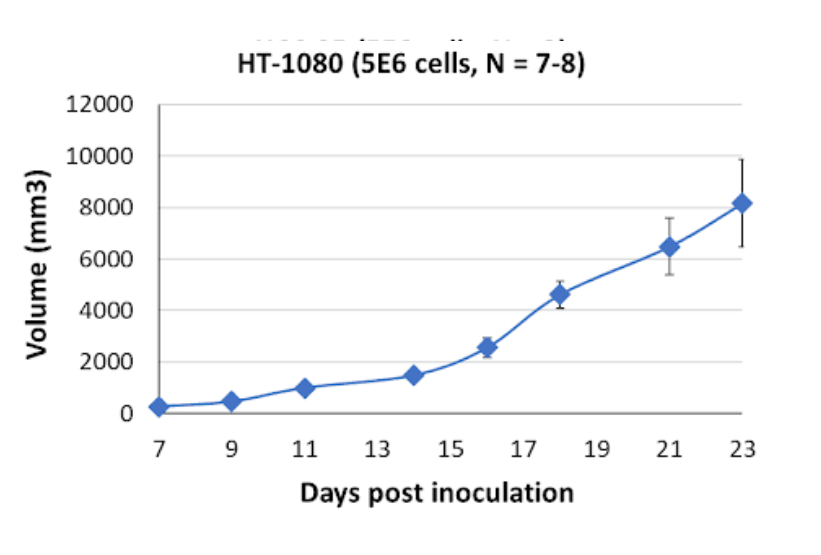About HT-1080
The HT-1080 cell line, established in 1964 from a tumor sample of a 35-year-old male patient with fibrosarcoma in the thigh, is a valuable tool for studying the biology and behavior of fibrosarcoma. These cells exhibit an adherent growth pattern, appearing spindle-shaped, and typically form a monolayer in culture. A significant genetic alteration observed in HT-1080 cells is the presence of an activated NRAS gene. NRAS is a proto-oncogene involved in regulating cell growth and division. When mutated and constitutively activated NRAS drives uncontrolled cell proliferation. The presence of the activated NRAS oncogene in HT-1080 cells provides a mechanistic understanding of the tumorigenic properties of fibrosarcoma and highlights the importance of targeting the NRAS pathway for potential therapeutic interventions.
Another notable mutation in HT-1080 cells is in the IDH-1 gene. This mutation affects the isocitrate dehydrogenase 1 enzyme, leading to the disinhibition of alpha-ketoglutarate-dependent dioxygenases. These dioxygenases play a role in DNA methylation and gene regulation. The IDH-1 mutation in HT-1080 cells leads to altered DNA methylation patterns, which can have downstream effects on gene expression and cellular behavior. Understanding the impact of the IDH-1 mutation provides insights into the epigenetic changes associated with fibrosarcoma development and progression.
HT-1080 cells display highly proliferative characteristics and have demonstrated anchorage-independent growth, a property associated with enhanced tumorigenic potential. These features make HT-1080 cells suitable for studying various processes involved in fibrosarcoma, including tumor invasion, metastasis, and angiogenesis. Additionally, HT-1080 cells have been employed in bioproduction assays, allowing researchers to investigate the production of extracellular matrix components such as collagens and glycosaminoglycans, which are often dysregulated in fibrosarcoma.
In terms of therapeutic susceptibility, HT-1080 cells have shown sensitivity to mTOR (mammalian target of rapamycin) and PI3K (phosphoinositide 3-kinase) targeted agents. These signaling pathways play vital roles in cell growth, survival, and proliferation, and aberrant activation can contribute to cancer development. Targeting mTOR and PI3K pathways has shown promise as potential treatment strategies for fibrosarcoma, and HT-1080 cells serve as a valuable model for studying the efficacy of these targeted agents.
HT-1080 Tumor Kinetics in the SRG™ Rat

In vivo, HT-1080 cell-derived xenografts reliably produce tumors that exhibit excess production of extracellular matrix components, including collagens and glycosaminoglycans. This characteristic reflects the aggressive and invasive nature of fibrosarcoma and provides a platform to investigate tumor progression, evaluate therapeutic responses, and study the interaction between tumor cells and the surrounding microenvironment.
Products & Services
Xenograft Efficacy Studies
Includes collection of blood, tissues & tumor for ADME, PK/PD and analysis.
(Bi)weekly Tumor Sampling
Via fine needle aspiration (FNA). For longitudinal evaluation of drug exposure, histology and gene expression.
OncoRats
Cutting edge models optimized for engraftment.
Get help with your research by scheduling a call with Hera.
References (MLA):
- Baksh, Sanjeethan, and Lydia Finley. “Metabolic Coordination of Cell Fate by α-Ketoglutarate-Dependent Dioxygenases.” Cell, 19 Oct. 2020, www.cell.com/trends/cell-biology/fulltext/S0962-8924(20)30190-2.
- Fong, Jason T., et al. “Alternative Signaling Pathways as Potential Therapeutic Targets for Overcoming EGFR and C-MET Inhibitor Resistance in Non-Small Cell Lung Cancer.” PLOS ONE, 4 Nov. 2013, journals.plos.org/plosone/article?id=10.1371%2Fjournal.pone.0078398.
- Wu, Long-Fei, et al. “Ferrous Iron and α-Ketoglutarate-Dependent Dioxygenases in the Biosynthesis of Microbial Natural Products.” Biochimica et Biophysica Acta (BBA) – Proteins and Proteomics, 1 Feb. 2016, www.sciencedirect.com/science/article/abs/pii/S1570963916300048?via%3Dihub.
